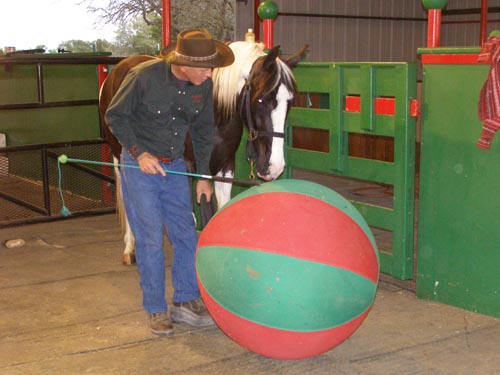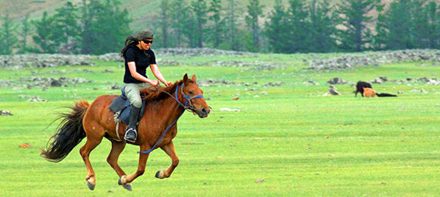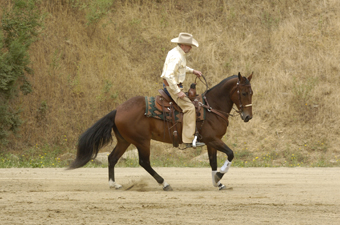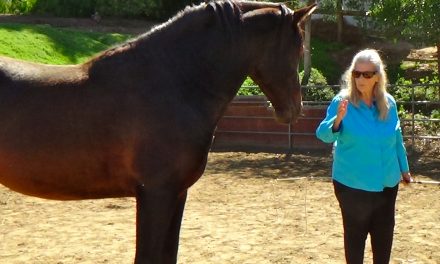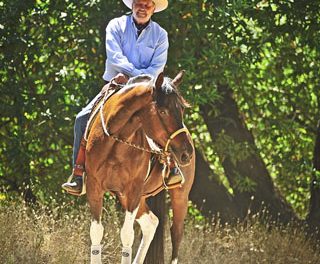The goal of Trick Training is to create a thinking horse that will be first and foremost an astute companion and pleasure mount and perhaps, ultimately, a performance horse. Ideally, a young horse can be started with challenges that are age appropriate and, just as in children, condition the individual into the habit of learning. Imagine A Horse training strategy focuses on increasing a horse’s brainpower for life before he is physically mature enough to withstand the demands of a disciplined sport. Although we teach our horses to “herd the big ball” before they are even weaned, a horse of any age can learn to play ball.
Trick Training gives both horse and human a vehicle to help develop confidence through successful completion of creative learning challenges. Confidence translates into malleable boldness and what we call a can-do attitude. With encouragement and achievable goals, a horse’s can-do attitude evolves into a want-to-do work ethic.
Large horse appropriate balls are currently very popular among horse folks who use them to “desensitize” horses and even to play mounted soccer. We say “that’s great, but it is only the first step”. Teaching a horse to play ball and actually herd it back to the handler is a cool trick and it has lots of benefits.
Benefits
*Rolling a ball helps give the horse yet one more exercise/reason to lower his head and stretch his back.
*Rolling a ball challenges his creativity and appeals to his natural curiosity.
*Rolling a ball usually triggers his herding instinct.
*Rolling a ball requires the horse to use both of his eyes and eventually, nose-eye coordination while his feet are moving.
*Rolling a ball is a fun way for you to interact with your horse.
Teaching a horse to herd or roll a big ball can be an interesting study as some horses will develop the ability to control and even predict the moving direction of the ball. Horses that respond in this manner demonstrate a completely different and higher level of usable intelligence than horses that will only respond to a cue. Learning to anticipate or predict the outcome of where the ball will end up is the sign of a very clever equine mind.
Herding the ball requires an equine student that has an inquisitive and outgoing personality as well as a desire to learn and interact with a human. There is no way to force this trick onto a horse – he must choose to interact, play, and to learn.
Here’s how
At first, place the ball where the equine student can see it in his normal surroundings such as the aisle of the barn. Let her get used to seeing you push it around with you as you feed or go about some chores. Working cow horses are initially allowed to visually “track” a cow before they are started on actual cow work. We like to let the horse track the ball before we start teaching him to herd it. When the horse is comfortable with watching you rolling the ball, lead him as you push (slowly) the ball in front of you so he can learn to track it. At this point it is time to take your horse and the ball into a training stall, aisle or small square corral preferably with a level floor.
Walk with the horse at your side either in-hand or at liberty as you roll the ball. Use either your outstretched fingers or the butt of a whip to slowly move the ball. Your body position should mimic the move that you are requesting from your horse; head lowered, eyes focused inquiringly on the ball. Most horses will reach forward to investigate the ball with his nose. When this happens, immediately reward him either with a word of praise and an encouraging stroke on the shoulder, or a small food treat. At first, if the horse only lowers his head a couple of inches to look more closely at the ball, reward him. Make a big deal out of his touching it. Most horses will learn in short order that touching the ball pleases you and/or earns a treat or cookie. We usually condition the horse to the verbal cue of “push it”.
In the first sessions, the goal is to have the horse approach, touch and then push the ball. When these initial behaviors are going well, incorporate small goals. The goal may be to push the ball along a wall of the working enclosure and a designated corner. Stay with the horse or keep him in hand on a loose lead to encourage him. Extra praise or a jackpot of treats is required every time the “goal” is reached. Each time you and the horse roll the ball into the chosen corner, give an extra reward. Encourage the horse to think that it was his effort that caused the ball to reach the goal.
Tips
*Understand your horse’s maximum concentration time.
*Keep your patience and focus.
*Do not get frustrated with your horse’s progress or lack thereof.
*Stay close to him until the pushing with the nose behavior is confirmed.
*Although some horses will begin to push the ball almost immediately, don’t expect each horse to do this.
*Each tiny push or touch (in the beginning) is an accomplishment
*A horse needs your support, encouragement and engagement to stay motivated and focused.
*Don’t leave the ball with the horse without supervision. Use it only as an interactive training tool.
*Each horse’s incremental progress is different, know your horse.
Typically, within about a week, a horse will begin to get into the spirit of the game and start rolling the ball completely on his own. After a horse has learned to predictably roll the ball along a wall and then into a corner, the handler can move slightly away from the horse as he herds it. If the horse has been taught to “Come” to the handler, you can begin to ask the horse to “Come” as he pushes the ball into the corner. Over time, as the horse’s nose and eye coordination develops, you can move to different locations in the stall and reward the horse when he pushes the ball to you.
The journey through Enlightened Trick Training is an interesting way to create an intelligent, cooperative and eager horse. For more information on Enlightened Trick Training and to order “Horse Tuff” balls visit www.imagineahorse.com
If you have questions regarding teaching any of the “tricks” or moves in this series please email the authors at suesmonet@aol.com

